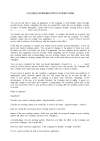Introduction to this document
Flexible working application form
All employees now benefit from the statutory right to request a flexible working arrangement but they cannot make more than two requests for flexible working within any twelve-month period. If an employee makes a formal request, you need to deal with their application in a reasonable manner.
Flexible working entitlement
Under the statutory right to request a flexible working arrangement, employees can apply to vary the hours they work, the times they work or their place of work (between their home and your place of business).
Handling requests in a reasonable manner
You are required to handle the employee’s flexible working request in a reasonable manner and notify them of your decision on their application within two months. This includes any appeal period. There is also a statutory Acas Code of Practice on requests for flexible working and this will be taken into account by employment tribunals in deciding relevant cases. The Acas Code of Practice states as follows in relation to dealing with a request in a reasonable manner:
• the employee must make a written and dated request stating that it’s a statutory request for flexible working, setting out the flexible working arrangement they seek and the date on which they would like the change to come into effect: see the Flexible Working Application Form. Note. The employee must also confirm if and when they have made a previous application for flexible working to you
• the employee may make two statutory requests for flexible working within any twelve-month period, but there can only be one live request at any one time – once a request has been made, it remains live until either you make a decision about it, it’s withdrawn, an outcome is mutually agreed or the statutory two-month decision period for deciding requests ends. A request also continues to be live during any appeal or extension to the decision period that may be mutually agreed
• once you have received a written request, you must handle it in a reasonable manner and this includes carefully assessing the effect of the requested change for both you and the employee
• unless you decide to agree to the employee’s flexible working request in full, you must consult with them before making a decision. In such cases, you should invite them to a consultation meeting to discuss their request. A consultation meeting can help make sure that all relevant information is understood before a decision is made. It’s good practice to allow the employee to be accompanied by a work colleague, a trade union representative or a trade union official at the meeting (and at any appeal meeting) and the meeting should be held without unreasonable delay: see the Flexible Working Request – Invitation to Meeting. The meeting can be held in person or remotely via online video conferencing or, where neither of those are possible, via telephone call. The person chairing the meeting should have sufficient authority to make a decision, and you should keep a written record of the meeting
• the meeting should allow for a reasonable discussion and consideration of the employee’s request. If their original request cannot be accepted in full, you should discuss any potential modifications to the request or any alternative flexible working options that may be available and suitable for both parties. It may also be helpful to discuss whether a trial period may be appropriate to assess the feasibility of an arrangement
• once you have made a decision about the employee’s request, you must inform them in writing of your decision without unreasonable delay. You must agree to a request unless there is a genuine business reason not to
• if you agree to the employee’s request, or you agree a modified or alternative flexible working arrangement after consulting with them, your written decision should confirm the details of the agreed arrangement – you will need to establish a start date and provide a written note of the contract variation. Your decision letter should also offer the employee an opportunity for a discussion to clarify any further information that may be helpful in implementing the agreed arrangement: see the Flexible Working Acceptance Letter
• if the employee’s request is refused, it must be for one of eight statutory business reasons, and you should clearly explain those business reasons and set out any additional information which is reasonable to help explain your decision. Although there is no statutory right of appeal, allowing an appeal is good practice and therefore your decision letter should make it clear that the employee has the option to appeal the decision, including explaining how to appeal and the timeframe for submitting an appeal: see the Flexible Working Rejection Letter. Note. You must never refuse a request unless the employee has first been consulted about the request.
• if you receive an appeal, you should arrange an appeal meeting without unreasonable delay and then deal with the appeal impartially. The person chairing the appeal meeting should have sufficient authority to make a decision and, wherever possible, they should be a manager who has not previously been involved in considering the employee’s request. Once a decision about the appeal has been made, it should be confirmed to the employee in writing without unreasonable delay: see the Flexible Working Appeal - Invitation to Meeting and the Outcome of Flexible Working Appeal Meeting Letter
• all requests, including any appeals, must be considered and decided on within a statutory decision period of two months from first receipt, unless you agree with the employee to extend this period. If an extension is agreed, you should confirm this in writing to the employee: see the Extension of Flexible Working Decision Period.
Document

UPDATED02 Apr 2024


